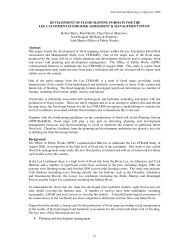Vegetation (Floating River Vegetation) - Office of Public Works
Vegetation (Floating River Vegetation) - Office of Public Works
Vegetation (Floating River Vegetation) - Office of Public Works
You also want an ePaper? Increase the reach of your titles
YUMPU automatically turns print PDFs into web optimized ePapers that Google loves.
6.0 Conclusion and summary<br />
•Arterial drainage works, which involve excavation <strong>of</strong> the riverbed, are likely to cause a<br />
significant negative impact on floating river vegetation and their habitats. If hydraulic<br />
conditions are suitable floating river vegetation may recolonise the watercourse.<br />
•Arterial drainage maintenance carried out in accordance with the Environmental Drainage<br />
Maintenance (EDM) Programme causes a minor negative impact or a minor positive<br />
impact on habitats supporting floating river vegetation. The mitigation measures proposed<br />
will tend to lead to a minor positive impact. In certain cases excessive floating river<br />
vegetation growth may occur and additional maintenance may be required in these<br />
circumstances.<br />
•<strong>Floating</strong> river vegetation was present on most <strong>Office</strong> <strong>of</strong> <strong>Public</strong> <strong>Works</strong> main channels. No<br />
floating river was evident on the <strong>River</strong> Maigue. It is uncertain whether floating river<br />
vegetation was present on the Owenriff <strong>River</strong> due to flood waters observed during the<br />
survey.<br />
•Parameters influencing the diversity <strong>of</strong> floating river vegetation include shade, water<br />
depth and water flow. Other parameters that affect growth are water quality, adjoining<br />
land use, riverbed substrate and habitat encroachment by terrestrial plant species.<br />
•In general terms deep waters were inhabited by Pondweed species. Fast water flow<br />
favoured some water crowfoot species; slow water flow favoured other water crowfoot<br />
species, starworts, and some pondweed species. Shallow water supported aquatic moss<br />
and sections <strong>of</strong> watercourses with silt deposits were colonised by water parsnip.<br />
•Although no confirmed identification <strong>of</strong> R.fluitans was recorded during the course <strong>of</strong> this<br />
survey, the true species identification <strong>of</strong> Ranunculus spp. could not be undertaken due to<br />
the absence <strong>of</strong> flowering structures.<br />
53

















